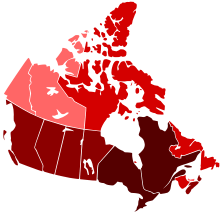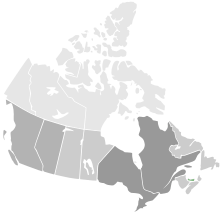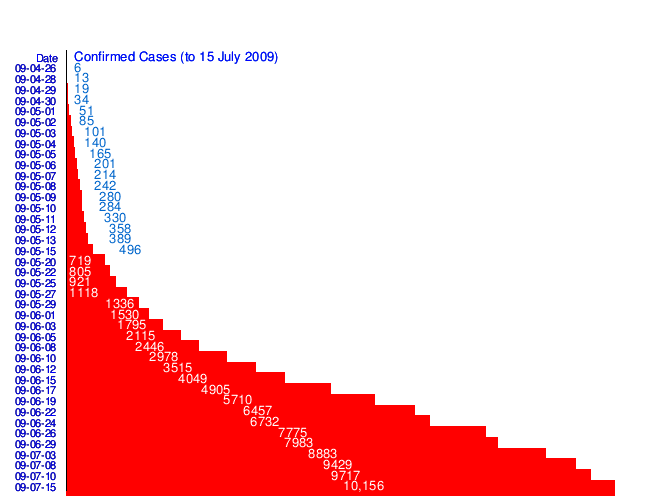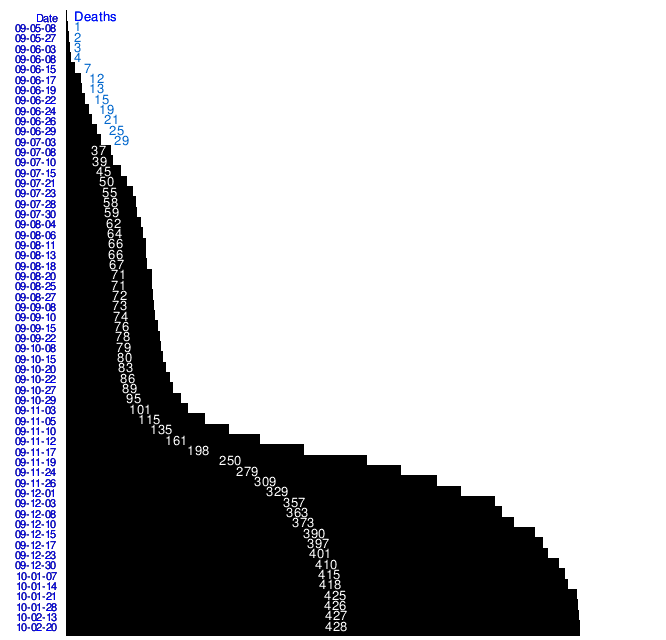2009 flu pandemic in Canada
|
Deaths Confirmed cases | |
|
2000+ cases 500+ cases 100+ cases 1+ cases | |
|
1+ deaths 5+ deaths 20+ deaths
Outbreak evolution in Canada | |
| Disease | Swine flu |
|---|---|
| Virus strain | H1N1 |
| Arrival date | 26 April 2009 |
| Origin | Thought to be Veracruz, Mexico |
| Deaths | 428[1] |
| Suspected cases‡ | 1.5 million (by 20 November 2009) |
| ‡ Suspected cases have not been confirmed as being due to this strain of influenza by laboratory tests, although some other strains may have been ruled out. | |
The 2009 flu pandemic in Canada is part of an epidemic in 2009 of a new strain of influenza A virus subtype H1N1 causing what has been commonly called swine flu. In Canada, roughly 10% of the populace (or 3.5 million) has been infected with the virus,[2][3] with 428 confirmed deaths (as of 20 February 2010);[1] non-fatal individual cases are for the most part no longer being recorded. About 40% of Canadians have been immunized against H1N1 since a national vaccination campaign began in October,[4] with Canada among the countries in the world leading in the percentage of the population that has been vaccinated.[2][5] The widespread effect of H1N1 in Canada has raised concerns during the months leading to the XXI Olympic Winter Games, which took place in Vancouver on February 2010.[6]
Human cases
Alberta
As of 9 April 2010, there were 1,278 confirmed hospitalized cases in Alberta.[7]
On 2 May 2009, Canadian Food Inspection Agency executive vice-president Brian Evans announced that an infected Alberta farm worker recently returned from Mexico had apparently passed the virus to a swine herd in his care. Although the herd had been quarantined, Evans stressed that the infection represented no threat to food safety and judged the possibility of infected pigs passing the virus back to humans "remote". Evans said the infection of the herd was the first known case of the H1N1 virus being transmitted from humans to pigs.[8] Transmission from the same herd of pigs back to humans was revealed on 20 July, though it occurred on 7 May when the humans, health inspectors, were taking samples from the infected herd with improper self-protective measures.[9]
On 8 May, health officials in Alberta confirmed that swine flu contributed to the death of a woman in Northern Alberta on 28 April, Canada's first death associated with the illness.[10][11][12][13][14][15]
As of 14 August 2009, there were 1,648 confirmed cases of swine flu in Alberta. Health and Wellness Alberta stopped reporting non-hospitalized cases on 21 August.[7]
British Columbia
The B.C. government has reported 1,059 severe flu cases as of 2 February 2010. 49 of 56 fatalities were people with underlying medical conditions.[16] The province is no longer reporting non-severe cases (Total cases reached 676 by 10 August).[17]
The initial cases in British Columbia involved two young men aged 25–35 from the B.C. Lower Mainland who had recently come back from Mexico, according to Danuta Skowronski, head of flu and respiratory illnesses at the BC Centre for Disease Control, run by the provincial government. The cases were discovered by normal flu testing conducted by the disease control centre after the men had visited a doctor about flu-like symptoms. She noted the disease seemed "widespread" in Mexico and should not be mistaken by tourists to be linked only with urban Mexico City.[18] The first fatality in British Columbia caused by the H1N1 virus occurred on 14 July, and was a young child who died within 24 hours of being rushed to the hospital.[19] There were concerns of H1N1 during the months leading up to the 2010 Winter Olympics that occurred in Vancouver on February 2010, as a result volunteers were required to be vaccinated.[6] On 28 January, Perry Kendall, the provincial health officer, stated that the chances of a third wave of H1N1 were "diminishing". However, he maintained that vaccinations continued to be recommended for all and are vital for reducing the risk of another wave of H1N1.[20]
Manitoba
As of 5 October 2009, there were 892 confirmed cases in the province, with 7 deaths associated with the H1N1 virus.[21] As of 1 February 2010, there had been 1,774 new confirmed cases, with 4 deaths since the start of the "second wave" 6 October.[21]
On 3 May, the first case in Manitoba was confirmed in the Brandon area.[22] The second case in Manitoba was announced on 12 May. The second case, a Winnipeg woman in her 50s was admitted to hospital, although the province noted she also has an unidentified underlying medical condition.
Newfoundland and Labrador
As of 4 January 2010, there were 267 hospitalized cases in the province.[23]
On 13 June, Newfoundland and Labrador reported their first case of swine flu, becoming the final province to do so. The case involves a sample collected from a young man who was treated Thursday 11 June at the hospital in Grand Falls-Windsor.[24]
The first recorded death of a person with swine flu was recorded on 1 November 2009, when a 36-year-old woman died from the virus.[25]
New Brunswick
The first case in New Brunswick was confirmed to be present in Greater Moncton on 1 May 2009.[26]
By 28 August, there had been 147 confirmed cases in New Brunswick. New cases are no longer being reported. The first deaths occurred 13 November.[27]
Northwest Territories
On 1 June, the Northwest Territories confirmed their first case of swine flu.[28] The first death occurred in November.[1]
Nova Scotia
From the beginning of the 2009–10 flu season in September until 2 December, there were 739 confirmed cases, including 255 hospitalizations.[29]
First cases: Nova Scotia's chief medical officer, Robert Strang, said on 26 April that the National Microbiology Laboratory in Winnipeg confirmed late the previous day that four people in the province between the ages of 12 and 18 were recovering from "relatively mild" cases of the disease. The four people were students attending King's-Edgehill School preparatory school in Windsor, Nova Scotia. One of the infected students had been on a recent school trip to the Yucatán Peninsula in southern Mexico.[30][31]
Nunavut
On 16 July 2009, Nunavut reported its first swine flu death.[32] As of 5 August, there were 496 confirmed cases of the swine flu.[33]
Ontario
There were 8,633 confirmed cases in Ontario, with 1,725 hospitalizations as of 10 December.[34]
On 27 April 2009, four cases were suspected to be swine flu in Ontario. This number grew to ten cases in five days.[35] On 25 May, Ontario Health Minister David Caplan confirmed that a Toronto man in his 40s had died of the virus.[36][37]
The Toronto region had been a secondary epicentre during the 2003 SARS epidemic, and have been taking extra precautions against the H1N1 virus in the early stages of the pandemic.[38]
Ontario is also home to what is believed to be the youngest Canadian death from swine flu. A two-month-old baby was admitted to the London Health Sciences Centre on 2 November 2009; the boy died in the early morning two days later.[39] This death, is one of three recently reported in London, Ontario, and has brought the number of confirmed deaths from H1N1 since April in Ontario to 95 as of 26 November 2009.[1]
Ontario updates its H1N1 cases Thursdays here.
Prince Edward Island
As of 8 December 2009, there were 50 hospitalizations in the province, and no deaths.[40]
Prince Edward Island confirmed its first two cases in Charlottetown on 4 May 2009.[41]
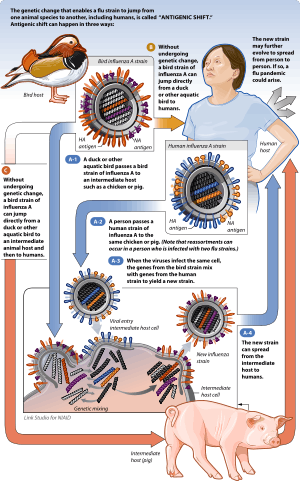
Quebec
There had been 2,422 hospitalized cases as of 4 December 2009.[42]
While an early case Quebec turned out not to be swine flu,[43] on 30 April 2009, the first case in the province was confirmed in the Greater Montreal Area.
The first case of death was announced on 8 June, making the total of 4 deaths for Canada. The person was a more than 65-year-old woman suffering from respiratory diseases before being hospitalized on 2 June. According to medical expertise, she had never traveled to Mexico and had no contact with those who did.[44]
Confirmed cases totalled 10,714 between 30 August and 4 December 2009.[42]
Saskatchewan
The first cases were confirmed on 7 May in the Saskatoon and Regina areas.[45]
The province stopped counting individual cases as of 23 July 2009. At that point there were 888 confirmed cases.[46]
Yukon
On 12 May 2009, the Yukon Territory reported its first case of swine flu.[1] The first death was a school-aged girl who died on 1 November.[47]
Totals
| Province/Territory | Confirmed Deaths by 20 February[1] | Increase Reported 14 – 20 February[1] |
|---|---|---|
| British Columbia | 57 | 1 |
| Alberta | 71 | 0 |
| Saskatchewan | 15 | 0 |
| Manitoba | 11 | 0 |
| Ontario | 128 | 0 |
| Quebec | 108 | 0 |
| New Brunswick | 8 | 0 |
| Nova Scotia | 7 | 0 |
| Prince Edward Island | 0 | 0 |
| Newfoundland | 18 | 0 |
| Yukon | 3 | 0 |
| Northwest Territories | 1 | 0 |
| Nunavut | 1 | 0 |
| Total | 428 | 1 |
Progression Chart
Non-human cases
On 2 May, the first incidence in Canada of the flu in pigs was discovered on a farm in Alberta.[49] It is suspected that an infected farmhand who recently returned from Mexico infected the animals.[50]
In Canada in early June, the Alberta pig farmer whose herd was infected with the new swine flu virus culled his entire herd. In May he had already culled 500 animals from his herd. The farm owner said the animals could not be marketed because they are under quarantine and he was facing a problem with overcrowding.[51]
Response
Michael Gardam, director of infectious disease prevention and control at the Ontario Agency for Health Protection and Promotion, said in an interview with the CBC that an outbreak of swine flu in Ontario, Canada's most populous province, would not be as serious as the 2003 SARS epidemic.[52] In preparing for and dealing with an influenza pandemic, the Public Health Agency of Canada follows the WHO's categories, but has expanded them somewhat.[53] Despite initial reports of two swine influenza cases in Montreal's Lakeshore General Hospital, Johanne Simard of the Montreal Regional Health Board confirmed negative results for all quarantined patients at the hospital and that no quarantines were currently in effect at the hospital.[54] The National Microbiology Laboratory in Winnipeg confirmed cases of human swine influenza virus in clinical specimens sent from Mexico[55] and the Canadian government issued a travel advisory for Mexico, warning Canadians who have returned from the country of the severe respiratory illness.[56]
On 26 April, the Government of Nova Scotia announced on a live webcast that four students in Windsor, Nova Scotia, have confirmed cases of swine flu.[57] Later that day, the Federal Government confirmed the existence of a total of six cases in Canada; four in Nova Scotia and two in British Columbia. Federal Health minister Leona Aglukkaq said the Canadian federal government would take whatever measures were necessary to keep the public safe, and that as Canada continued to ramp out its surveillance efforts there would likely be more reported cases. She also said she had been in contact with her provincial and territorial counterparts and had ordered the Public Health Agency of Canada to alert border authories, quarantine officers and other officials.[58] However, Canada's Chief Public Health Officer, David Butler-Jones, stated that the six affected Canadians suffered from only mild symptoms and have already started to recover. However, Butler-Jones warned against complacency, stating that the fact that only mild cases have been reported so far "doesn't mean we won't see either some more severe illness or potentially deaths."[59] In both provinces, the cases either involved people who had recently returned from Mexico or those in close contact with such people.[60]
In a step towards understanding the outbreak, and developing a vaccine, Canadian scientists completed the first full genetic sequencing of the H1N1 swine flu virus on 6 May.[61]
The high percentage of mild to severe cases amongst First Nations Peoples in Manitoba and Northern Ontario, when compared to the general population, have raised questions about the vulnerability of these communities to H1N1 across Canada.[62][63] Concerns have also risen about whether the Canadian government's pandemic preparation plan is able to properly address the specific needs of these communities.[64]
Timeline
See also
- 1918 flu pandemic
- Avian flu
- Severe acute respiratory syndrome (SARS)
- List of Canadian medical disasters
References
- ↑ 1.0 1.1 1.2 1.3 1.4 1.5 1.6 "Bi-weekly and cumulative number of deaths due to Pandemic (H1N1) 2009, by province/territory, Canada". Public Health Agency of Canada. 28 January 2010. Archived from the original on 11 February 2010. Retrieved 4 February 2010.
- ↑ 2.0 2.1 Alphonso, Caroline (25 November 2009). "Severe allergic reaction seen after H1N1 flu shot". Globe and Mail (Toronto). Archived from the original on 27 November 2009. Retrieved 28 November 2009. "Roughly 10 per cent of Canadians have been infected, and another 25 per cent have been immunized."
- ↑ "The H1N1 question: Is the flu virus mutating dangerously?". Globe and Mail (Toronto). 20 November 2009. Archived from the original on 28 November 2009. Retrieved 28 November 2009. "(In Canada alone, for example, an estimated 3.5 million people have been infected with the flu.)
- ↑ "H1N1 'not done yet':Canada's top doctor". CBC: CBC. 15 December 2009. Retrieved 15 December 2009.
- ↑ "One quarter of Canadians immunized for H1N1: Top doc". Toronto Star. 16 November 2009. Archived from the original on 19 November 2009. Retrieved 28 November 2009. "The country's chief public health officer says almost one-quarter of Canadians have been immunized against swine flu. David Butler-Jones says Canada is leading the world when it comes to the percentage of the population vaccinated."
- ↑ 6.0 6.1 http://uk.eurosport.yahoo.com/28102009/2/2010-athletes-spectators-urged-h1n1-shots.html
- ↑ 7.0 7.1 "H1N1 Influenza Virus – Confirmed Cases in Alberta". Government of Alberta. Health and Wellness. Retrieved 2 November 2009.
- ↑ "Alberta pigs likely infected with flu from worker: CFIA official". CBC News. 3 May 2009. Archived from the original on 4 May 2009. Retrieved 3 May 2009.
- ↑ "Swine-flu inspectors in improper gear got virus". CBC News. 20 July 2009. Retrieved 2 November 2009.
- ↑ "Two cases of swine flu confirmed in Alberta". CTV Media. 28 April 2009. Archived from the original on 1 May 2009. Retrieved 23 May 2009.
- ↑ "Alberta confirms 2 cases of swine flu". CBC News. 28 April 2009. Archived from the original on 29 April 2009. Retrieved 29 April 2009.
- ↑ "Edmonton-area girl among six new Alberta swine flu cases". CTV News. 4 May 2009. Archived from the original on 7 May 2009. Retrieved 29 April 2009.
- ↑ "Alberta confirms first H1N1 flu fatality". CTV News. 8 May 2009. Archived from the original on 11 May 2009. Retrieved 8 May 2009.
- ↑ O'Neill Katherine, Walton Dawn (8 May 2009). "Alberta woman Canada's first H1N1-related death". Globe and Mail (Toronto). Retrieved 2 November 2009.
- ↑ Armstrong Kevin (8 May 2009). "Alberta confirms first H1N1 flu fatality". CTV News. Archived from the original on 11 May 2009. Retrieved 8 May 2009.
- ↑ "B.C. Ministry of Health Services". Archived from the original on 22 October 2009. Retrieved 2 November 2009.
- ↑ "H1N1 Flu Virus (Human Swine Flu) Under Surveillance". Government of British Columbia (Ministry of Health Services). Archived from the original on 22 October 2009. Retrieved 2 November 2009.
- ↑ Ebner David (26 April 2009). "Swine flu confirmed in Canada". Globe and Mail (Toronto). Retrieved 2 November 2009.
- ↑ "B.C. confirms 1st swine flu death". CBC News. 14 July 2009. Retrieved 2 November 2009.
- ↑ "Risk of third H1N1 flu wave in B.C. 'diminishing': Top doctor". The Province. 28 January 2010. Archived from the original on 30 January 2010. Retrieved 30 January 2010.
- ↑ 21.0 21.1 "General Information on Lab-Confirmed Cases of Pandemic H1N1 Influenza". Manitoba Health and Healthy Living. 1 February 2010. Archived from the original on 24 November 2009. Retrieved 27 November 2009.
- ↑ "Flu strain arrives in Manitoba". Winnipeg Sun. 3 May 2009. Retrieved 23 May 2009.
- ↑ "Information on H1N1 Influenza Virus". Health and Community Services. Government of Newfoundland and Labrador. 4 January 2010. Archived from the original on 20 January 2010. Retrieved 5 January 2010.
- ↑ "First swine flu case finally confirmed in N.L.". CBC News. 13 June 2009. Retrieved 2 November 2009.
- ↑ "N.L. records 1st H1N1-related death". CBC News. 1 November 2009. Archived from the original on 3 November 2009. Retrieved 2 November 2009.
- ↑ "Public health confirms 1st swine flu case in N.B.". CBC News. 1 May 2009. Archived from the original on 4 May 2009. Retrieved 1 May 2009.
- ↑ flu bulletins available at "Influenza Surveillance Activities in New Brunswick". New Brunswick Health. Archived from the original on 26 October 2009. Retrieved 2 November 2009.
- ↑ "Nova Scotia H1N1 Summary". 2 December 2009. Retrieved 9 December 2009.
- ↑ "Flu Update, Sunday, April 26, 2009" (Press release). King's-Edgehill School. 26 April 2009. Archived from the original on 29 April 2009. Retrieved 26 April 2009.
- ↑ "Health officials confirm 6 cases of swine flu in Canada". CBC News. 26 April 2009. Archived from the original on 29 April 2009. Retrieved 23 May 2009.
- ↑ "Nunavut reports 1st swine flu death". CBC News. 16 July 2009. Archived from the original on 27 September 2009. Retrieved 25 September 2009.
- ↑ "Ontario Influenza Bulletin – Surveillance Week 47 (November 22, 2009 – November 28, 2009)". Health Ontario. 2 December 2009. Retrieved 8 December 2009.
- ↑ "Ontario probes suspected swine flu cases amid pandemic fears". CBC News. 27 April 2009. Archived from the original on 30 April 2009. Retrieved 23 May 2009.
- ↑ "3rd person to die with swine flu in Canada was from Ontario". CBC News. 2 June 2009. Retrieved 2 November 2009.
- ↑ Theresa Boyle (1 June 2009). "Second swine-flu death in Toronto". The Star (Toronto).
- ↑ McCaughey, Betsy (30 April 2009). "To control swine flu lets heed the lessons of SARS". New York Daily News. Archived from the original on 3 May 2009. Retrieved 23 May 2009.
- ↑ "Two-month-old who died likely had H1N1". National Post (London, Ont.). 4 November 2009. Archived from the original on 6 November 2009. Retrieved 5 November 2009.
- ↑ "P.E.I. Department of Health – Hospital Surveillance". 8 December 2009. Retrieved 8 December 2009.
- ↑ "P.E.I., N.B. confirm more swine flu cases". The Canadian Press. 4 May 2009. Retrieved 4 May 2009.
- ↑ 42.0 42.1 "Statistiques descriptives de la grippe pandemique A(H1N1)". 4 December 2009. Archived from the original on 10 December 2009. Retrieved 8 December 2009.
- ↑ Staff Writer (25 April 2009). "Two released from quarantine at Lakeshore General". Montreal: CTV. Retrieved 27 April 2009.
- ↑ Kevin Dougherty (9 June 2009). "Quebec has first swine flu death". The Gazette (Montreal). Archived from the original on 14 June 2009. Retrieved 23 June 2009.
- ↑ "2 swine flu cases in Saskatchewan". CBC. 7 May 2009. Archived from the original on 9 May 2009. Retrieved 7 May 2009.
- ↑ "H1N1 Flu Virus Surveillance Results". Government of Saskatchewan. Ministry of Health. 22 October 2009. Archived from the original on 29 November 2009. Retrieved 17 November 2009.
- ↑ http://www.newsrunner.com/display-article/?eUrl=http%3A%2F%2Fwww.cbc.ca%2Fcanada%2Fnorth%2Fstory%2F2009%2F11%2F02%2Fyukon-h1n1-death.html%3Fref%3Drss&eSrc=CBC.ca&eTitle=Yukon+girl+dies+from+swine+flu+complications
- ↑ Government of Canada – Health Canada: Update bulletins for influenza A H1N1 2009 (human swine influenza)
- ↑ Lauren Etter (3 May 2009). "Pigs in Canada Contract Flu Virus". Wall Street Journal. Archived from the original on 5 May 2009. Retrieved 3 May 2009.
- ↑ "Canada farm worker 'infects pigs'". BBC News. 3 May 2009. Archived from the original on 4 May 2009. Retrieved 3 May 2009.
- ↑ "3,000 Alberta hogs culled due to swine flu" Health Zone – Canada, 7 June 2009
- ↑ Ljunggren David, Anderson Scott (24 April 2009). "Swine flu not as serious as SARS: Canada's Ontario". Reuters. Archived from the original on 27 April 2009. Retrieved 23 May 2009.
- ↑ "The Canadian Pandemic Influenza Plan for the Health Sector". Public Health Agency of Canada. Archived from the original on 21 May 2009. Retrieved 23 May 2009.
- ↑ "Swine-flu fears at Lakeshore General unfounded". Montreal: The Gazette (Montreal). 25 April 2009. Archived from the original on 27 April 2009. Retrieved 25 April 2009.
- ↑ "Canadian lab confirms human swine flu cases in Mexico". CBC News. 24 April 2009. Archived from the original on 29 April 2009. Retrieved 1 May 2009.
- ↑ "Travel advisory warns of severe respiratory illness in Mexico". CBC News. 23 April 2009. Archived from the original on 26 April 2009. Retrieved 1 May 2009.
- ↑ "Health officials confirm swine flu in Canada". The Canadian Press. 26 April 2009. Retrieved 26 April 2009.
- ↑ Staff Writer (26 April 2009). "6 cases of swine flu confirmed in Canada: health officials". CBC News. Archived from the original on 29 April 2009. Retrieved 23 May 2009.
- ↑ Brennan Richard J (26 April 2009). "Swine flu confirmed in Canada : Unlike deadly outbreak in Mexico, the cases in Nova Scotia and B.C. were mild and didn't require hospitalization". Toronto: The Star. Archived from the original on 19 May 2009. Retrieved 23 May 2009.
- ↑ Staff Writer (26 April 2009). "Six swine flu cases confirmed in Canada". CTV Media. Archived from the original on 29 April 2009. Retrieved 26 April 2009.
- ↑ "H1N1 virus genome: 'This is a world first'". The Independent (Press release). Cape Town. Agence France Press. 6 May 2009. Archived from the original on 16 June 2009. Retrieved 6 May 2009.
- ↑ "Aboriginal populations vulnerable to H1N1: Report". The Montreal Gazette. 3 July 2009. Retrieved 4 July 2009.
- ↑ "First Nations prime ground for H1N1 pandemic". The Star Phoenix. 19 June 2009. Archived from the original on 21 June 2009. Retrieved 2 July 2009.
- ↑ "First Nations Chief In Manitoba Declares State Of Emergency Over H1N1 Virus". AHN. 25 June 2009. Archived from the original on 27 June 2009. Retrieved 2 July 2009.
External links
| Wikimedia Commons has media related to 2009 flu pandemic in Canada. |
- Canadian
- FightFlu.ca. Updates from the public Health Agency of Canada
- Health Canada: Preparing for a pandemic (Government of Canada)
- Public Health Agency of Canada: Swine Influenza
- International
- Swine influenza, at the World Health Organization
- WHO's Pandemic Influenza Phases
- Influenza Research Database – Database of influenza genomic sequences and related information.
- Confirmed and Suspected Cases
- Centers for Disease Control and Prevention (CDC): Swine Influenza (Flu)
- Medical Encyclopedia Medline Plus: Swine Flu
- Medical Encyclopedia WebMD: Swine Flu Center
| ||||||||||||||||||||||||||||||||||||||||
| ||||||||||||||||||||||||||||||||||||||||||||||||||||||||||||||||||||||||||||||||||||||||||

